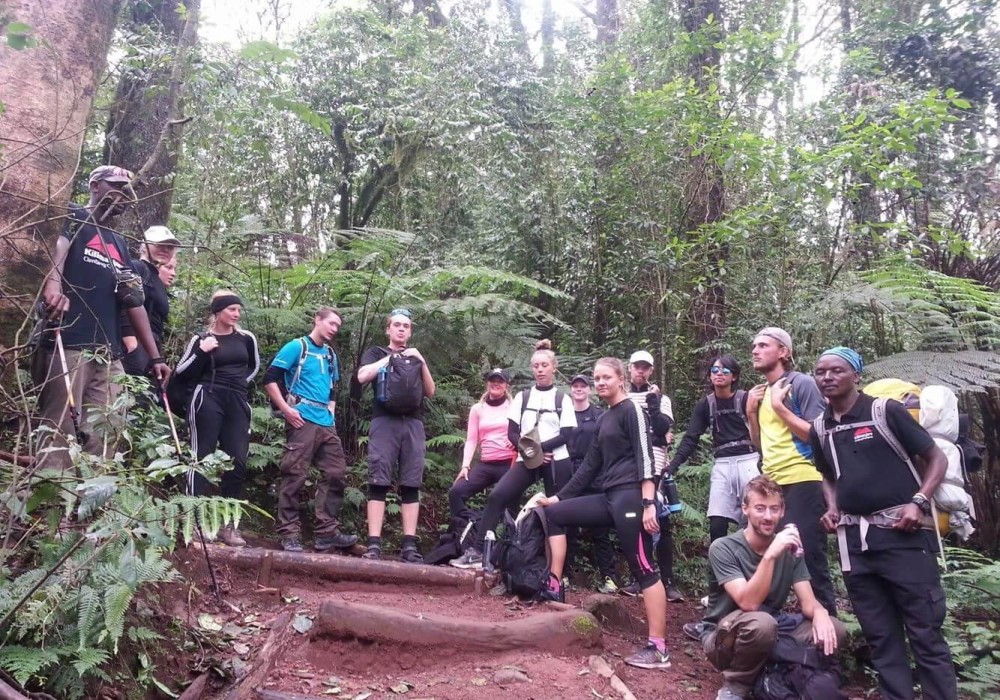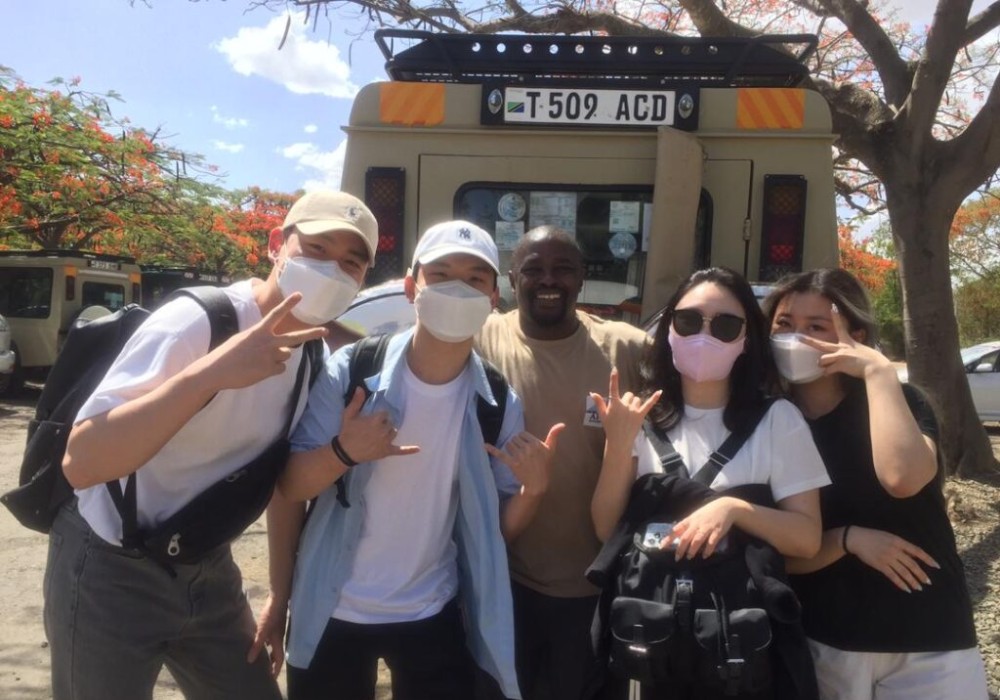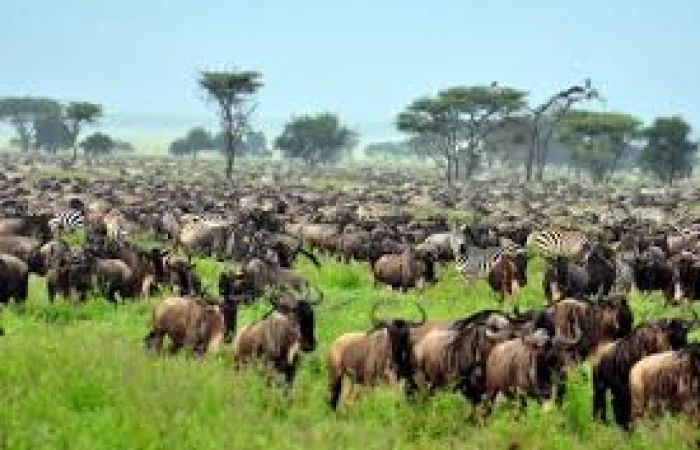Tour highlight
-
Main Destination :Kilimanjaro
-
Tour may be offered as :
- Trek
- Hiking
-
Tour Duration:Day: 6Night: 5
-
You Visit:
- Arusha
- Moshi
Tour Over View:
Marangu is the easiest route on Mount Kilimanjaro. It’s ascension profile is very gradual and steady, allowing for painless trekking most of the way. However, due to its reputation as an easy route, Marangu is often selected by unprepared, inexperienced climbers. Correspondingly, only about 35% of the people actually make it to the top.
The trek begins in the south-east area of the mountain at Marangu Gate. The route takes a minimum of five days to complete, although six days is more practical and recommended. The sleeping huts along the route are structures with a dining hall and bunk beds, equipped with mattresses and pillows. The descent is done on the same path, contributing to Marangu’s overcrowded feeling. It is a cheaper climb as well, due to the close proximity of the gate to Moshi, the gateway town, and because it is a shorter route.
Scenically, Marangu is not a desirable route compared to all the other routes because it confines climbers to one area of the mountain, thus limiting the variety. However, Marangu has the best trail in the rainforest section of the trek. Of course, there are still great views of the Mawenzi, and it’s equally spectacular for everyone at Uruhu.
Marangu is ideal for those who are not confident in their ability to hike over steeper paths. It’s also attractive for those who do not want to sleep in a tent. Marangu’s huts offer shelter and warmth against the weather, so they are a decent choice when climbing during the rainy season. Marangu is for those who want to spend less on their climb and do not mind crowds.
Marangu is the easiest route on Mount Kilimanjaro. It’s ascension profile is very gradual and steady, allowing for painless trekking most of the way. However, due to its reputation as an easy route, Marangu is often selected by unprepared, unexperienced climbers. Correspondingly, only about 35% of the people actually make it to the top.
The trek begins in the south-east area of the mountain
Tour itinerary:
The Marangu Route also known as the “Coca-Cola Route,” is the oldest and most well established trekking route on Mount Kilimanjaro, and it remains extremely popular mainly because it is the only route on the mountain that has hut accommodation for trekkers.
Marangu Route Zebra Rock
This path provides trekkers with the classic Kilimanjaro climbing experience, offering sweeping views and a wonderful hiking adventure all the way to the summit of Uhuru Peak. That said, it also has some unique aspects that set it apart from any of the other routes, giving the Marangu route a character and feeling that are entirely its own.
Marangu route starting point
One of the more interesting aspects of the the the the the Marangu Route is that it is the only route up Mount Kilimanjaro that doesn’t allow camping, so instead of sleeping in tents, trekkers stay in permanent huts instead.
These dormitory-style shelters provide extra protection from the wind and rain, which makes this route a popular one for travelers climbing during the rainy season, which comes in April and May. There are 60 bunk beds each at Mandara and Kibo Huts, and 120 bunk beds at Horombo Hut
While staying at those huts, trekkers will sleep in bunk beds equipped with a simple mattress and pillow. They’ll also be able to purchase an array of candy bars, bottled water, and soft drinks, which is why Marangu route is often referred to as the “Coca-Cola Route.”
Marangu Route offers a slow, steady climb to each of the daily camps, which has given it the reputation for being an easy trek. Don’t underestimate this trail however, as the approach to the final camp can be physically demanding with roughly 1000 meters of vertical gain on that day alone.
Of course, summit day on Kilimanjaro is always a challenge no matter which direction you approach from, making the final steps onto the top all the more satisfying.
Because it is one of the shortest treks to the summit – requiring just five days to reach Uhuru Peak – the Marangu Route is a popular one with trekkers who have a limited amount of time for their climb.
The downside to this is that it doesn’t provide as much of an opportunity to acclimatize to the altitude. Because of this, Marangu route has the highest failure rate of any of the routes up Mount Kilimanjaro. Keep that in mind when choosing this option for your Kilimanjaro trek.
The Marangu Route is also the only route that uses the same path going up and coming back down. That means that while the trail is a scenic one, trekkers will experience the same sites going up as they do going back down. And because it has traffic going both directions, Marangu can also get overly crowded at times too.
Still, for a classic Kilimanjaro experience, it is tough to top this tried and true route to the Roof of Africa.
Climbing Kilimanjaro offers Marangu as five or six day private climb. The five day variation does not have an acclimatization day on day three at Horombo Hut.
Marangu Route 6 Day Itinerary Overview
Starting from Marangu Gate to the summit and back to Marangu Gate. For a day-by-day itinerary for the Marangu Route please click on this link: 6 day Marangu Route
Marangu Route Detailed Itinerary
Below, you will find a comprehensive 5 night/6 day climb up Kilimanjaro via the Marangu Route. If you would like to shorten your route to 5 days, skip the night of the Acclimatization Day and continue walking straight from the Horombo Huts to the Kibo Huts in one day.
Day 1: Mandara Huts
Once you have finished breakfast, it is time to leave Arusha and head towards the southeast entrance of Kilimanjaro National Park, better known as Marangu Gate. Upon arriving at Marangu Gate, you will be given the time to check-in and register. This is where you begin your ascent of Kilimanjaro. The first leg of this route takes you through the woods and the rainforest where you will be able to take in the eucalyptus trees and various species of birds. If you are lucky, you may just spot a Colobus monkey or two – keep an eye out for black or white fur! Make sure you have the appropriate equipment and footwear because the low altitudes can produce wet, muddy soil.
Hiking: 5-7 hours
Overnight Altitude: ~8,858
Habitat: Rainforest
Day 2: Mandara Huts – Horombo Huts
To start off day 2, you will explore the final stretch of woodland as the massive stretch of moorland begins to open up right in front of your eyes. On your walk, you can appreciate the jagged peaks of Mawenzi that ascend up towards the skies of Africa. It is common for people to experience the onset of altitude sickness at these heights. It is important to pay attention to how you feel and communicate with your guide at the first and slightest indication of illness. After reaching the Horombo Huts, you will have time to unpack and experience the view of Kibo before dinner.
- Hiking: 5-7 hours
- Overnight Altitude: ~12,205
- Habitat: Heath/Moorland
Day 3 Acclimatization Day
You will spend an extra day at the Horombo Huts to allow your body to acclimate to the increasingly high altitude. You must stay at camp and relax if you are showing any signs of illness or are feeling especially tired.
However, if you feel well-acclimated to the altitude, then you are free to walk up to Mawenzi Hut and admire the incredible view of Kibo and Mawenzi. Keep a steady pace as you walk the route and enjoy the magnificent landscape. Otherwise, you can take a journey to the remarkable Zebra Rocks. This requires a climb of 310 meters.
- Hiking: 1-2 hours
- Overnight Altitude: ~14,400
- Habitat: Heath/Moorland
Day 4: Horombo Huts – Kibo Huts
On day 4, you will walk through varied and strikingly picturesque landscapes. To begin, you will continue across the heath as it slowly turns into the parched, desolate highlands between Mawenzi and Kibo. The scenery here is littered with huge and small volcanic rocks, acting as a testament to the volcanic activity of years past. The final stretch to the Kibo Huts is very steep and physically challenging.
Once you arrive at the Kibo Huts, it is time to organize your equipment and warm clothes for tomorrow’s journey to the peak.
To prevent freezing, keep any water you plan on bringing in a thermos. Get to bed early, as the next day’s trek requires a full night’s worth of energy. You are getting ready to take on Kilimanjaro’s ultimate challenge!
- Hiking: 5-7 Hours
- Overnight Altitude: ~15,430
- Habitat: Alpine Desert
Day 5 Kibo Huts Gilman’s Point Uhuru Peak Horombo Huts
As you awaken around midnight, there is just enough time for a small meal before you begin your nightly hike. Many hikers consider the difficult terrain, scattered with loose rocks, to be the most difficult part of the climb. The goal is to reach Gilman’s Point by dawn. This is to make sure that you can make it to Uhuru, the highest point of Kibo, shortly after sunrise. There will be a quick stop at Gilman’s Point to experience the glorious view. Afterward, you will continue along the edge of the crater to Uhuru – this is the last part of the ascent and features a steady incline.
Depending on when you take your journey, you may face snow on the final stretch of the path to Uhuru Peak, the highest point in Africa and the very top of Kilimanjaro. As you reach the peak, at an altitude of 5,895, you can congratulate yourself as you experience the astounding view and get a picture in front of the Uhuru Peak Sign.
Now that it is time to start back towards the Kibo Huts, you will find that this part goes by incredibly quickly. At the Kibo Huts, you will stop to relax and enjoy a much-needed lunch, before moving along to the Horombo Huts, where you will enjoy a well-deserved full night’s rest.
- Hiking: 4-5 Hours
- Overnight Altitude: ~12,205
Day 6: Horombo Huts Marangu Gate Arusha
As we make the final descent through the rainforest to the Marangu Gate, we will have lunch and say farewell to our mountain crew. Afterward, we will leave Mount Kilimanjaro National Park and drive back to Arusha for a much-needed shower and a commemorative dinner!
- Hiking: 5-7 Hours
- Overnight Altitude: `1,843
- Habitat: Alpine Desert
Frequently Asked Questions:
- How difficult is the Marangu Route?
This route is attempted by many novice hikers every year as it offers comfortable hut accommodations, as opposed to other routes that require you to sleep in mountain tents. Many people attest that this route is less difficult compared to other hikes to the top of Kilimanjaro.
It is a common misconception for trekkers to perceive a 5-day hike as easier than a 6-day hike. However, the 5-day options can be very difficult as they do not allow for much time to acclimate to the altitude. The 6-day option is much easier, but a good level of fitness is still required.
What is the distance of the Marangu Route, and how many days does it take to complete it?
The exact distance on the Marangu Route is 82 kilometers, or 50 miles. The shortest number of days required for the Marangu Route is 5 days, however, when you take into consideration the arrival and departure days, it is 9–10 days. As the Marangu Route is the shortest route on the mountain, it is best to complete the journey over six days to increase your chances of success.
- What is the Maragu Route Summit Success Rate?
As it is one of the shortest routes on the mountain, the Marangu Route has the lowest summit success rates. This is mainly because of the unprofessional local tour guides who take groups up the mountain on the shorter 5-day hike. Because of this, the 5-day average success rate is 50%! We advise our hikers with this in mind, so we only take the 6-day option, which increases the success rate to over 90%!
- What scenery will I see on the Marangu Route?
The Marangu route ascends through the rainforest, moorlands, and alpine areas before ending in the glacial zone. This trek is very beautiful and is the only route that allows you to descend the same way you ascended.
- What is the best time to journey through the Marangu Route?
Between July and September, it is the best time to climb Kilimanjaro. The weather is the most stable during this period, and encountering rain is less likely. Since it is close to the equator, it is possible to climb the mountain at any time during the year. Be cautious, April and May are the wettest months, so this period is best avoided.
Include
- Accommodation & Logistics
- Airport transfers
- Two nights bed and breakfast hotel accommodation
- Return transfers to and from the Kilimanjaro gate
- Excess gear storage at the hotel
- KCC Operations Manager on standby for you during your stay
- Expedition briefing & equipment check
- Kilimanjaro park & camping fees
- Mountain rescue permit
- Staff wages
- Bilingual guides
- Expedition porters & cooks
- 3 hot meals per day & snacks at camp
- Uhuru Peak or Stella Point certificate of achievement
Safety & Equipment
- Helicopter evacuation
- Expedition First Aid Kit
- Medical oxygen and means of evacuation off the mountain
- High quality 3 man Berghaus expedition sleeping tents
- Mess tent with table & chairs
- Boiled water for drinking & washing
- Private toilet
Exclude
- Items & services NOT included
- International flights to and from Kilimanjaro
- Entry visa ($50 Europe / $100 USA) - which can be obtained upon arrival
- Personal travel INSURANCE (specific to high-altitude trekking and travel in rural Africa)
- Gratuities
- Vaccinations for travel to a region

- GodyTour Expert
- Tour Expert
6 days marangu route kilimanjaro
Tanzania offers a range of accommodations to suit different preferences and budgets. Options include luxury lodges, tented camps, mobile camps, and budget-friendly campsites. Some lodges and camps are located inside the national parks, while others are situated in private concessions adjacent to the parks.
Tanzania is known for its diverse wildlife. On a safari, you can expect to see animals such as lions, elephants, giraffes, zebras, wildebeests, buffaloes, leopards, cheetahs, rhinos (in a few select areas), hippos, crocodiles, and a variety of antelope species. Birdlife is also abundant in Tanzania.
The duration of your safari depends on your interests and the specific areas you wish to visit. Many people opt for a 4- to 7-day safari, which allows for a good wildlife experience in multiple parks. However, it's also possible to extend your safari and combine it with other attractions, like the beaches of Zanzibar or cultural visits.
The best time for a safari in Tanzania depends on what you want to see and experience. The dry season from June to October is popular as wildlife congregates around water sources. The wildebeest migration usually takes place from December to July. However, different parks have different peak seasons, so it's advisable to research specific regions and their seasonal patterns.
Essential items to pack for a Tanzania safari include lightweight and breathable clothing, comfortable walking shoes, a hat, sunscreen, insect repellent, binoculars, a camera, and any necessary medications. It's also advisable to pack layers for cooler mornings and evenings, as well as a waterproof jacket in case of rain.
Tanzania is generally considered safe for tourists, including safari-goers. However, it's always advisable to exercise caution and follow the guidance of your tour operator or guide. Be aware of your surroundings, listen to instructions, and take necessary precautions to ensure a safe and enjoyable experience.
Yes, most visitors to Tanzania require a visa. You can obtain a visa in advance from a Tanzanian embassy or consulate, or you can get a visa on arrival at the airport or border entry points. It's recommended to check the visa requirements and application process beforehand to ensure a smooth entry into the country.





























